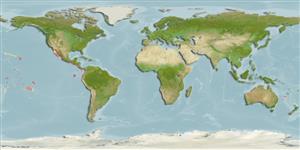>
Anguilliformes (Eels and morays) >
Ophichthidae (Snake eels) > Ophichthinae
Etymology: Myrichthys: Greek, myros, -ou = male of morey eel + Greek, ichthys = fish (Ref. 45335).
More on author: Girard.
Issue
Synonym of M. xysturus accdg. to Ref. 6852.
Environment: milieu / climate zone / depth range / distribution range
Ecologia
marinhas associadas(os) a recifes; intervalo de profundidade 0 - 60 m (Ref. 5227). Tropical; 32°N -
Eastern Pacific: Gulf of California to Peru, including the Galapagos Islands.
Tamanho / Peso / Idade
Maturity: Lm ? range ? - ? cm
Max length : 74.0 cm TL macho/indeterminado; (Ref. 5227); common length : 60.0 cm TL macho/indeterminado; (Ref. 55763)
Inhabits sandy and muddy bottoms, from shallow waters up to a depth of 25 m. Can be seen at times in daylight searching for prey under rocks and in crevices over rocky bottoms, or buried completely in the sand when inactive (Ref. 6852).
Life cycle and mating behavior
Maturidade | Reprodução | Desova | Ovos | Fecundidade | Larvas
McCosker, J.E. and R.H. Rosenblatt, 1995. Ophichthidae. Tiesos, serpentones. p. 1326-1341. In W. Fischer, F. Krupp, W. Schneider, C. Sommer, K.E. Carpenter and V. Niem (eds.) Guia FAO para Identification de Especies para lo Fines de la Pesca. Pacifico Centro-Oriental. 3 Vols. FAO, Rome. (Ref. 9328)
Categoria na Lista Vermelha da IUCN (Ref. 130435: Version 2024-1)
Ameaça para o homem
Harmless
Utilização humana
Pescarias: sem interesse
Ferramentas
Relatórios especiais
Descarregue XML
Fontes da internet
Estimates based on models
Preferred temperature (Ref.
123201): 20.5 - 28.7, mean 25.9 °C (based on 80 cells).
Phylogenetic diversity index (Ref.
82804): PD
50 = 0.5005 [Uniqueness, from 0.5 = low to 2.0 = high].
Bayesian length-weight: a=0.00091 (0.00039 - 0.00215), b=2.99 (2.79 - 3.19), in cm total length, based on LWR estimates for this (Sub)family-body shape (Ref.
93245).
Nível Trófico (Ref.
69278): 3.5 ±0.5 se; based on size and trophs of closest relatives
Resiliência (Ref.
120179): Médio, tempo mínimo de duplicação da população 1,4 - 4,4 anos (Preliminary K or Fecundity.).
Fishing Vulnerability (Ref.
59153): Moderate to high vulnerability (50 of 100).
Nutrients (Ref.
124155): Calcium = 38.4 [21.5, 68.0] mg/100g; Iron = 0.511 [0.313, 1.025] mg/100g; Protein = 18.8 [16.5, 21.3] %; Omega3 = 0.111 [0.051, 0.312] g/100g; Selenium = 46.4 [26.9, 90.0] μg/100g; VitaminA = 50.4 [15.2, 149.8] μg/100g; Zinc = 0.95 [0.68, 1.31] mg/100g (wet weight);
